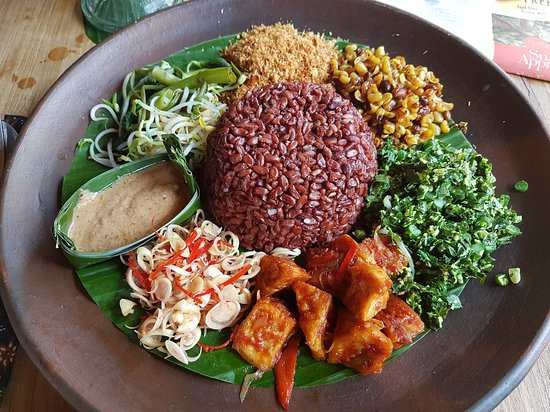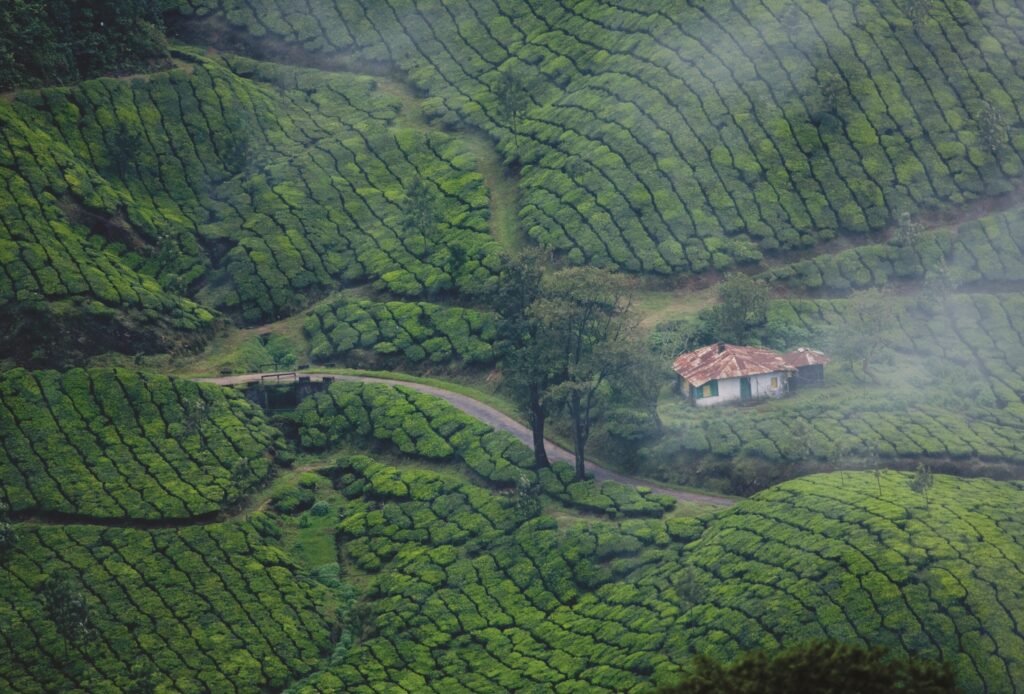Introduction to Balinese Cuisine
Balinese cuisine represents a vibrant tapestry of flavors, ingredients, and cooking techniques that are deeply rooted in the traditions and cultural heritage of the island of Bali, Indonesia. The uniqueness of balinese food can be attributed to its geographical location, which boasts a rich diversity of fresh produce, spices, and herbs that are integral to its culinary identity. The island’s proximity to the sea not only affords access to an array of seafood but also influences the locals’ dietary habits and religious practices, weaving a complex narrative into the gastronomic landscape.
One of the defining characteristics of Bali food is its use of aromatic spices, with common staples such as ginger, turmeric, garlic, and chili pepper forming the foundation of many traditional dishes. These elements bring depth and complexity to the food, setting it apart from other Indonesian cuisines. Moreover, the preparation methods, which often include grilling, steaming, and slow-cooking, further enhance the flavors, resulting in dishes that are both visually appealing and satisfying to the palate.
Cultural aspects also play a pivotal role in shaping balinese cuisine. Family gatherings, religious ceremonies, and festivals often showcase an elaborate spread of dishes, where food is not merely sustenance but a means of expressing gratitude and respect towards the deities. The presentation of the food, often adorned with vibrant offerings, reflects the island’s spiritual beliefs and the significance of community in Balinese life.
As we explore the exciting flavors of this extraordinary culinary journey, readers will gain an appreciation for not only the delicious dishes but also the stories and traditions that enrich the experience of savoring balinese food. Each subsequent section delves into specific flavors that highlight the grandeur of this intricate culinary art, inviting you to discover the essence of Bali through its remarkable cuisine.
The Role of Spices in Balinese Cooking
Spices are the cornerstone of Balinese food, playing a crucial role in defining its bold and vibrant flavors. The use of various spices not only enhances the taste of dishes but also contributes to the overall sensory experience of traditional Balinese cuisine. Among the most prominent spices, turmeric stands out for its vibrant yellow color and distinct earthy flavor. It is commonly used in many Bali food preparations, contributing not only to the overall taste but also offering significant health benefits, such as anti-inflammatory properties.
Another essential spice in Balinese cooking is galangal, which lends a unique, aromatic quality to dishes. Its sharp, citrusy flavor is often found in traditional soups and curries, making it a key ingredient that elevates the taste profile of various meals. Galangal is frequently paired with lemongrass, another staple in Balinese food. The refreshing, lemony aroma of lemongrass enhances the overall aroma of dishes, infusing them with a fresh zest that is characteristic of the region’s culinary practices.
The combination of these spices creates a symphony of flavors that are emblematic of Balinese cuisine. For instance, in a popular dish like “Bebek Betutu”—slow-cooked duck seasoned with an array of spices—the harmony of turmeric, galangal, and lemongrass culminates in a dish that is rich in flavor and texture. Additionally, the health benefits of these spices cannot be understated, as they are known for promoting better digestion, reducing inflammation, and providing antioxidants, thereby enhancing not just gastronomy but overall wellbeing.
Through the thoughtful incorporation of these spices, Balinese cooking reflects a deep respect for tradition and natural ingredients, crafting meals that are not only pleasurable to the palate but also nourishing to the body. This fundamental aspect of Balinese food underlines its significance in the broader spectrum of culinary arts and cultural identities in Indonesia.
Nasi Goreng Bali (Balinese Fried Rice)
Nasi Goreng Bali, or Balinese fried rice, is a quintessential dish that embodies the rich culinary heritage of Bali. This beloved meal is not only popular among locals but also holds a special place in the hearts of tourists exploring the diverse offerings of Bali food. The dish is characterized by its fragrant, savory flavors, which come from an array of aromatic spices and fresh ingredients found in the region.
The foundation of Nasi Goreng Bali is often prepared using leftover rice, which is stir-fried with a combination of garlic, shallots, and chili, forming a robust base. Unique Balinese ingredients such as shrimp paste and kecap manis, a sweet soy sauce, elevate its taste, making it distinctively different from other varieties of fried rice available in Indonesia. The addition of vegetables such as carrots, peas, and scallions adds vibrant color and nutritional value, while protein sources like chicken, shrimp, or even tempeh can further enhance the dish, catering to various dietary preferences.
One of the appealing aspects of Nasi Goreng Bali is its versatility. Numerous variations exist, allowing chefs to incorporate local vegetables and proteins, which ultimately reflects the individual styles of different regions and households. For instance, some versions may include fried eggs on top, while others might feature a side of crispy fried shallots, offering additional texture and flavor. The captivating aroma that wafts through the air when this dish is being prepared is sufficient to entice any passerby, making it a must-try for those seeking to immerse themselves in authentic Balinese food.
Nasi Goreng Bali not only provides a taste of the island’s culinary diversity but also serves as a comfort food that brings people together. Its simple yet flavorful nature makes it an enduring favorite amongst food lovers and a prime example of the unique blend of flavors characteristic of Balinese cuisine.
Bebek Betutu (Slow-Cooked Duck)
Bebek Betutu is a renowned dish hailing from Bali, celebrated for its profound flavors and unique cooking techniques. This slow-cooked duck dish epitomizes the rich culinary heritage of Balinese food, exemplifying the region’s intricate culinary processes. To prepare Bebek Betutu, a whole duck is marinated for an extended period, typically overnight, in a blend of spices known as bumbu. These spices often include turmeric, ginger, galangal, lemongrass, and various chilies, which impart a complex flavor profile to the meat.
The marination process is crucial, allowing the spices to deeply penetrate the duck, ensuring that each bite is bursting with flavor. After marination, the duck is traditionally wrapped in banana leaves before being slow-cooked, a method that not only enhances the taste but also helps retain moisture. The slow-cooking technique can take several hours, during which the duck becomes incredibly tender, absorbing the aromatic flavors of the spices and herbs. The result is a succulent dish that is both fragrant and rich, making it a centerpiece of many Balinese feasts.
Bebek Betutu holds a significant place in Balinese culture, often served during ceremonial occasions such as weddings and religious celebrations. The dish symbolizes prosperity and abundance, making it a staple at important gatherings. When exploring Bali food, one cannot overlook this emblematic dish, as it encapsulates the island’s culinary tradition and the communal spirit surrounding its preparation and enjoyment. Savoring Bebek Betutu is not just about tasting a delicious meal; it is an immersion into the vibrant culture of Bali. In conclusion, Bebek Betutu is a luxurious dish that all food enthusiasts should experience when visiting the island.
Sate Lilit (Minced Meat Satay)
Sate Lilit is a distinctive culinary delight that showcases the rich flavors of Balinese food, presenting a unique twist on the beloved traditional satay. Instead of the usual cubed meat skewered onto bamboo sticks, Sate Lilit features minced meat that is skillfully mixed with an array of aromatic spices and then wrapped around its bamboo stick counterpart. This innovative method transforms the dish, allowing for a more intimate interaction between the meat and seasonings, resulting in a flavor-packed bite.
The ingredients used for Sate Lilit vary, but the foundation typically consists of minced meat, most commonly chicken, beef, or fish, combined with fresh spices such as lemongrass, turmeric, garlic, and shallots. This blend imbues the dish with a vibrant taste that characterizes Bali food. A touch of gratorated,incorporated. adding richness and a slight sweetness that mellows the robust spice profile. The mixture is formed into long cylindrical shapes and carefully wrapped around bamboo sticks, ready for grilling.
You can find the best Sate Lilit in various locales throughout Bali, from street food vendors to traditional warungs (small family-owned restaurants). Popular areas to seek out this dish include Ubud, renowned for its authentic culinary experiences, and Seminyak, where upscale eateries creatively incorporate local flavors. For an authentic experience, visit local markets or food festivals where Sate Lilit is prepared fresh, highlighting the craftsmanship of Balinese chefs. Sampling this dish not only offers insight into Bali’s culinary traditions but also ensures that your taste buds are treated to an unforgettable experience.
Lawar (Traditional Salad)
Lawar, a traditional salad integral to Balinese cuisine, represents a vibrant amalgamation of flavors that epitomizes the culinary richness of Bali food. This dish is primarily composed of finely chopped vegetables, grated coconut, and a choice of minced meat or tofu, making it a versatile option for both carnivores and vegetarians alike. The balance of textures and flavors in Lawar results from the harmonious blending of ingredients such as green beans, papaya, or cabbage, seasoned with aromatic herbs and spices that evoke the essence of Bali.
There are numerous variations of Lawar, each differing by region and available ingredients. One of the most famous types is Lawar Merah, which incorporates the rich, red hues of minced meat with spices and fried coconut. Another popular variant is Lawar Putih, often featuring a chicken base complemented by fresh vegetables. These distinctive variations are not merely culinary delights; they also reflect the local agricultural practices and cultural heritage of the Balinese people. Lawar serves as a reminder of the harmonious relationship the community has with its land and resources.
Bali’s Famous Seafood Dishes
Bali, renowned for its stunning coastal landscapes and vibrant culture, is equally celebrated for its exquisite seafood dishes. The island is surrounded by rich waters that teem with a bountiful catch, making fresh fish and shellfish a staple in the local cuisine. For seafood lovers, enjoying Balinese food is an unforgettable experience that showcases the freshest ingredients available, primarily sourced from the surrounding ocean.
One must-try dish in Balinese seafood offerings is the Jimbaran grilled fish, a culinary delight not to be missed. This dish is typically prepared using locally caught fish, including snapper or grouper, which are marinated with traditional Balinese spices and then grilled to perfection. The coastal town of Jimbaran is famed for its beachfront seafood restaurants, where guests can dine with their toes in the sand as the sun sets over the horizon. The combination of the fresh ocean breeze and the rich flavors of Bali food creates an alluring atmosphere for indulging in seafood.
Another noteworthy seafood dish is the fish satay, locally known as “sate lilit.” This dish features minced fish mixed with coconut and aromatic spices, wrapped around bamboo skewers, and grilled to yield a smoky flavor. It embodies the essence of Balinese cooking, as it showcases not only the seafood but also the rich culinary traditions of the island. Additionally, various coastal restaurants offer unique takes on seafood, ensuring that visitors can explore the diverse flavors of Bali food.
Whether dining by the ocean or exploring local food markets, indulging in Bali’s fresh seafood dishes promises a delightful experience that highlights the island’s rich marine resources. Each dish is a testament to the skill and passion that characterize Balinese culinary artistry.
Sweet Balinese Treats
Balinese food is not only renowned for its savory dishes but also boasts a variety of delightful desserts that are cherished by locals and tourists alike. Among these traditional sweet treats, Dadar Gulung and Pisang Goreng stand out, capturing the essence of Bali’s rich culinary heritage.
A vibrant green pancake called dadar gulung is stuffed with a sweet mixture of grated coconut, palm sugar, and perhaps a pinch of pandan. The dough is made from rice flour, pandan juice, and a pinch of salt, cooked on a skillet until perfectly tender. This dish is a holiday classic that is frequently shared with family and friends. The preparation takes expertise to ensure that the pancakes are thin enough to highlight the sweet filling. The combination of sweetness from the coconut and the subtle flavor of pandan creates an irresistible balance that leaves a lasting impression on any palate.
Pisang Goreng, on the other hand, is a beloved fried banana dish that exemplifies the simplicity and comfort of traditional Balinese food.Ripe bananas are covered in a light batter and deep-fried till golden brown, creating a crispy shell that surrounds the delicate, sweet fruit inside. Often served with a drizzle of honey or a sprinkle of powdered sugar, Pisang Goreng is not just a dessert; it also serves as a popular snack enjoyed at any time of day. Its cultural relevance extends beyond just a sweet treat; it reflects the ingenuity of Balinese culinary practices by utilizing local ingredients in accessible yet delightful ways.
Both of these sweet Balinese treats offer an honest representation of Bali’s culinary culture, highlighting how traditional desserts are designed to delight the senses while fostering community and connection. The enjoyment of Dadar Gulung and Pisang Goreng truly symbolizes the shared values of celebration and togetherness inherent in Balinese food.
Where to Experience Balinese Cuisine
When embarking on a culinary journey through Bali, it’s essential to know where to find authentic balinese food that captures the rich flavors and cultural significance of the island. One of the best places to sample local dishes is at warungs, which are small family-owned eateries that serve traditional Bali food. These establishments often feature a rotating menu of home-cooked meals made with fresh, locally sourced ingredients, providing diners with an authentic taste of the island’s culinary heritage. Popular warungs such as Warung Babi Guling Ibu Oka in Ubud and Warung Mak Beng in Sanur are known for their signature dishes that should not be missed.
For a more upscale dining experience, Bali boasts numerous restaurants that elevate balinese food to fine culinary art. Establishments like Locavore in Ubud have gained international acclaim for their innovative use of local ingredients and traditional recipes. These high-end venues often focus on sustainability and creativity, presenting a modern twist on classic dishes. Dining at these restaurants can offer a more refined atmosphere while exploring the rich tapestry of Bali’s flavors.
Additionally, food markets provide a vibrant atmosphere where visitors can explore a variety of local dishes. The bustling night markets, such as Gianyar Night Market and Seminyak Village, offer an array of delicious options, from skewers of satay to sweet traditional desserts. These markets are ideal for trying multiple dishes in one visit, allowing diners to sample different aspects of balinese cuisine.
To navigate Bali’s culinary scene effectively, consider speaking with locals or joining a food tour. These options can lead you to hidden gems and lesser-known eateries that provide genuinely unforgettable experiences. Remember to approach your culinary adventure with an open mind, and be prepared to indulge in the diverse and palliative qualities of balinese food that reflect the island’s rich cultural influences.
Conclusion: Embracing Balinese Flavors
In exploring the delightful realm of Balinese food, we have journeyed through an array of vibrant dishes that showcase the rich culinary heritage of Bali. Each dish, from the aromatic Nasi Goreng to the quintessential Bebek Betutu, reflects the island’s diverse culture and its historical influences, making Balinese food not only a feast for the palate but also a celebration of tradition. The unique flavors and textures found in this cuisine captivate both locals and visitors, offering a dining experience that is truly unforgettable.
Moreover, the use of fresh ingredients, aromatic spices, and local herbs distinguishes Bali food from other culinary styles. Our journey has highlighted the significance of these elements in dishes such as Sate Lilit and Lawar, which draw from the island’s fertile land and abundant sea. These flavors are a harmonious blend of sweet, spicy, and savory that embody the essence of Balinese cooking. Thus, immersing oneself in the local dining options and street food can open doors to discovering not just flavors but stories shared among Balinese people.
As you embark on your own culinary adventure, consider seeking out traditional markets and warungs, where you can engage with locals and taste authentic Balinese dishes made with love and tradition. It is a wonderful opportunity to expand your palate while enriching your travel experience. By trying these unique flavors, you not only indulge in a gastronomic delight but also partake in the cultural tapestry that makes Bali a distinct destination. So, whether you are planning a visit or simply aiming to recreate these dishes at home, embrace the vibrant world of Balinese flavors and let it inspire your culinary journey.



